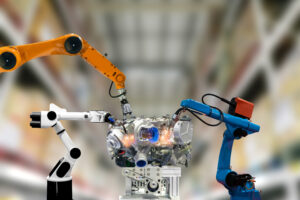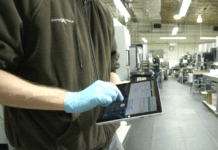It’s now two years into a pandemic that has disrupted the entire world. The arrival of COVID-19 caused manufacturers to scramble to rethink their businesses and address major financial, operational, and staffing challenges. Certainly, Covid-19 has added a layer of complexity to the challenges around recruitment, retention, and development that exist in the manufacturing industry.
Long Predicted Skills Gap
Let’s go back even further to look at the skills gap that was developing a decade ago—and how that plays into our human capital situation now.
Back in 2011, despite high general unemployment, a critical shortage of skilled workers threatened the future of manufacturing in America.
Tooling U-SME—and other experts—predicted that if the skills gap was not immediately addressed, the crisis would dangerously accelerate in the next decade.
We knew that between rapidly changing industrial technology and the pending retirement of millions of baby boomers, the manufacturing industry was going to be hit by serious depletion of talent.
At the time, we surveyed hundreds of manufacturers through our Workforce 2021 Readiness Assessment tool, and uncovered three areas that needed to be immediately addressed:
- Finding incoming employees
- Training incoming employees
- Upgrading the skills of incumbent employees to keep up with changing technology
These priorities haven’t changed. Here we are, a decade later, and we are in a workforce development crisis.
We were seeing some progress. Throughout the last decade, manufacturers have built momentum as they started creating and sustaining a strong talent pipeline. Strategies having a positive impact include:
- Onboarding programs
- Standardized on-the-job training (OJT)
- Defined career pathways
- Apprenticeships
- Competency models
- Strong educator connections (K-12 plus two and four-year educational institutions)
- Online training
 Covid-19 Arrives
Covid-19 Arrives
Then, in early 2020, Covid-19 arrived and changed the workforce.
The pandemic hastened retirements as many older employees did not want to risk infection by working onsite.
All industries, from foodservice to retail, lost employees. For some, remote education for children meant parents couldn’t work outside the home. Others didn’t want close contact with customers. Some employees found new jobs working from home.
Today, competition for employees is fiercer than ever.
A Gallup study shows 48 percent of employees are actively looking to make a change. And there are millions of job openings. US manufacturing is expected to have 2.1 million unfilled jobs by 2030, according to a Deloitte/The Manufacturing Institute study.
With salaries and incentives increasing across all industries, manufacturers are just one more option for candidates looking for new jobs.
Small and medium-sized manufacturers have especially been hit hard.
 Smart Manufacturing Momentum
Smart Manufacturing Momentum
At the same time, there has been another shift in the industry.
The pandemic has helped the manufacturing community realize it is time to accelerate the move to Smart Manufacturing. Companies have moved toward automation and robotics for health and safety reasons as well as to retain productivity despite, in some cases, fewer workers onsite.
Yet, manufacturers are at drastically different stages and of varied mindsets.
Recently, to help manufacturers at all stages, SME and CESMII – The Smart Manufacturing Institute, announced a partnership to drive Smart Manufacturing further and faster by aligning resources and educating the industry, helping companies boost productivity, and build a strong talent pipeline.
As Robert Willig, CEO, SME, said, “Together, CESMII and SME will optimize our strengths and resources to accelerate the transformation and democratization of the Smart Manufacturing ecosystem and jumpstart productivity.”
Together the two organizations are addressing the “digital divide” by connecting manufacturers to technical knowledge. These efforts will especially help small and medium-size companies—a large part of the supply network—to overcome the cost and complexity of automation and digitization that has constrained productivity and growth initiatives.
We are committed to ensuring small and medium-sized companies are prepared to deal with the daily challenge of recruitment, retention and upskilling to ensure their teams are prepared and trained to tackle a shift to Smart Manufacturing. This is critical so they are not left behind.
Larger manufacturers need their supply chain partners to have the capabilities to integrate with their digital systems. If that doesn’t happen, they will select companies that do. The gap between those innovating using SMART technologies and those who don’t will continue to grow—and there may be no catching up.
For optimum success, it is important to invest in employees so that they have the right knowledge and skills covering advanced technology topics. This ensures they know how to use the new equipment to its full potential. Then they can excel and innovate, allowing them to grow in their careers.
That’s why one of the first initiatives of the CESMII-SME partnership is focused on manufacturing workforce education. The program will leverage the extensive reach into industry and academia that we have at Tooling U-SME. In addition, the combined training portfolios of both organizations and new content collaborations will expedite Smart Manufacturing adoption, driving progress through transformational workforce development.

Optimizing Training Through Technology
At Tooling U-SME, we have already been taking action to help build awareness for the importance of starting this SMART journey – and providing tools to help.
We offer dozens of online classes including additive manufacturing, cybersecurity, data collection, and machine learning. Some customers tell us that it is easier to track the completion of courses for regulatory bodies when offered this way.
Our courses go well beyond Smart Manufacturing topics. Developed with manufacturing experts, we offer interactive and engaging online courses covering technical and non-technical subjects from machining to inspection to employability skills. With training resources such as short-term online classes, nationally recognized certifications, and assessments, we help companies build strong teams.
We frequently receive positive feedback about the flexibility of accessing the material wherever employees are, whenever they have free time.
This Spring, we are launching Tooling U-SME Virtual Reality (VR) Labs. The VR Labs, used with an Oculus VR Headset or on a computer, is an efficient way to safely apply your knowledge, contributing to confidence and proficiency on the shop floor.
This immersive experience allows for repeated practice after students or employees complete their eLearning curriculum and before training on real equipment. It’s a training approach that improves safety, increases productivity, and reduces costs.
It’s great for hiring too. The “gaming” aspect especially appeals to younger generations, helping generate excitement about a career in manufacturing.
While we don’t suggest that online learning will replace in-person instruction, on-the-job training (OJT) or hybrid training programs are here to stay.
Attract & Retain
In the end, whether for new hires or incumbent employees, engagement and retention come from creating a culture of learning and providing training opportunities tied to a clear career path.
Best practices before and after the first day include:
- Strong onboarding and buddy system
- Career pathways that align with pay
- Regular feedback, both formal and informal
Investing in workforce development and creating exciting career pathways empower people to build and innovate. Well-trained employees can identify operational improvements, new product ideas, and breakthrough enterprise-wide solutions to build a competitive advantage for manufacturers.
We need to ensure that progress on workforce development starts now so that we aren’t left at the end of the next decade wondering how nothing has changed. While a significant intervention around this topic is needed, consistent, small improvements can add up to effective recruitment, retention, and training practices that drive the growth and success of your company.






















